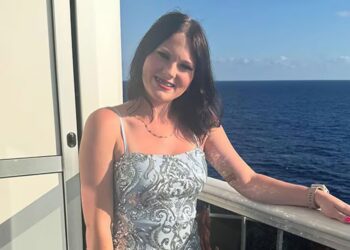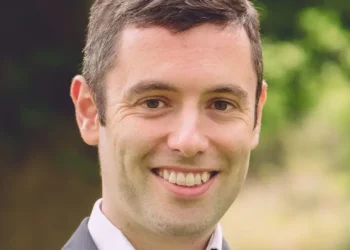For months, Jessica Newman has jolted awake gasping in the darkness at 5 a.m., just as she did on Jan. 8. Early that morning, as the Santa Anas whipped at 90 mph, sheriff’s deputies stormed through her Pasadena neighborhood ordering evacuations with flames at their heels.
Breathless as if the smoke still lingered, on a recent morning she bundled her effervescent 3-year-old daughter, Luna, into her car seat for the two-hour trek from her aunt’s house in Riverside, where they have lived for much of the past year, back to their family’s 1909 Craftsman home. It stands steps from the Eaton fire burn scar — untouched, but uninhabitable.
“It’s such an illusion,” Newman, 32, said of the home where she, her mother and her aunts all grew up. “The house looks so nice. You would never think there’s so much damage.”
At first blush, Newman seems equally vital. But her heart is dying, the result of a rare and often fatal complication of pregnancy that disproportionately affects Black women.
After her diagnosis in 2022, her late grandmother’s home became a refuge. The address enabled Luna’s hard-won spot in a subsidized preschool program, the family’s public benefits, access to Newman’s medical specialists and the elusive form of state health insurance — “straight Medi-Cal” — she needs for a transplant.
A year ago, after months of tests and procedures, she was poised to list for a new heart. Then came the fires.
Officials have long known that disabled residents are disproportionately likely to die in wildfires. It’s a pattern that has been repeated from Paradise to Lahaina, and again in Los Angeles, where Newman’s neighbors the Mitchells burned to death awaiting help that never came.
Now, emerging research shows disabled survivors are also disproportionately likely to suffer in the aftermath of an inferno — as much from smoke and ash as from bureaucratic intransigence and institutional failure.
In the chaos of the evacuation and the repeated displacements that followed, Newman lost her Medicaid-managed care plan exemption, and with it, the ability to join the wait list or even see her medical team.
Today, her transplant is tied up in a tangle of bureaucracy, her fate bound to a home she can’t live in and an address she can’t leave.
“I need that appointment now so that they can officially put me on the list,” she said. “To start that process over — it’s not like I can just transfer and say, ‘Oh, I was waiting over here.’”
Disabled Americans like Newman are far more likely to live in poverty, to rely on Medicaid and other public benefit programs, and to have health conditions that are exacerbated by toxic ash and smoke than those without disabilities, research shows. In the wake of a wildfire, they are left sicker, poorer, locked out of recovery programs and far less likely to ever get home, according to a Nov. 13 report from the University of Hawaii, based on the aftermath of the 2023 disaster in Maui.
“The danger here is really this slow-burning bureaucracy, which is leaving the most vulnerable [to wait] months and years for care and cleanup,” said Ruben Juarez, a professor of health economics at the University of Hawaii and a lead researcher in the Maui Wildfire Exposure Cohort Study.
The report by Juarez and his team found that for disabled people, the fires “deepened pre-existing disparities and introduced new pressures.”
Newman knows too well how these harms compound.
Her family’s house on Los Robles was her foundation of stability, but lingering damage from smoke, soot and ash — and the intransigence of agencies charged with removing it — makes going home impossible.
“When we get exposed to ash and all this stuff, we breathe faster and our heart beats faster,” said Dr. Peyman Benharash, a cardiothoracic surgeon at UCLA. “If someone’s heart is already pushed to the limit, it’s going to be much harder for them.”
On Tuesday, after months without seeing her cardiologist, Newman was admitted to Huntington Hospital gasping for air, afraid to even close her eyes at night lest her daughter wake up an orphan.
“You can’t help but think about the what-ifs,” Newman said. “What if I’m no longer there?”
January’s conflagration produced plenty of targets for public outrage. There were price-gouging landlords and GoFundMe grifters; L.A.’s mayor and her untested fire chief; an alleged arsonist’s blaze abandoned to rekindle; an Edison power line allowed to spark; and an emergency management system that left hundreds in harm’s way and panicked millions more with false alarms.
But above all for many, insurers have become the focal point of indignation.
Nearly a year after the inferno, tens of thousands of Angelenos are still displaced. Among them, an estimated 20% are exiled from standing homes, trapped in an endless cycle of testing, remediation and reevaluation for toxic contaminants — and met with resistance from insurers at every turn.
“We had good insurance,” said Benharash, the UCLA surgeon, who fled the Palisades fire in January. “Our house didn’t burn down, but it was full of soot inside. The insurance said, ‘We’ll clean it for you.’ But my wife tested it again and all the same chemicals are still there. It becomes an impasse.”
Experts and community activists say this is the norm for survivors with standing homes.
Insurance companies frequently refuse to pay industrial hygienists to test for dangerous contaminants such as lead and asbestos, or refuse to pay to have them safely removed when they’re found. Others will pay to test before cleaning or after, but not both, despite clear evidence from the Maui study and elsewhere that toxins sometimes persist.
Those who rely on the California FAIR Plan — the state’s “insurer of last resort” — face even steeper odds. Despite state officials and the courts directing it to pay out to remediate toxic contamination, the insurer is still rejecting many claims.
“Dealing with your insurance company is like another full-time job,” said Anastasia Mazzella, whose firm Kabateck LLP represents hundreds of Eaton fire victims in a suit against Southern California Edison, and who is displaced from her own still-standing home.
Faced with an immovable bureaucracy, Benharash and hundreds of other survivors simply gave up and left — a choice that often meant paying double to remain in the region or abandoning Los Angeles altogether.
Others, including many of Newman’s neighbors, gave up and went home, despite clear indications and sometimes solid proof those homes were still contaminated.
“This circular process of evaluation draws the testing and remediation out for months,” said Andrew Whelton, a professor of civil, environmental and ecological engineering at Purdue University. “That can lead to people being kicked off or denied [coverage for living expenses] and having to move back into their homes because it took so long.”
CalFAIR is legally required to clean up damage from smoke and ash — including contamination — but according to California’s Department of Insurance, it has “systematically” ducked hundreds of claims for the testing that would identify such toxins, and routinely low-balled payouts for those that were found.
California likewise requires Medi-Cal-managed care plans to pay for organ transplants, but has done little to ensure that any of the 13 heart transplant programs it approves or any of the surgeons who operate in those programs accept such plans, nor that the extensive care necessary to qualify for an organ is accessible to the poorest and most desperately ill.
Newman said she has been navigating a byzantine maze of public health insurance, reapplying for the Medi-Cal exemption that will allow her to once again see her specialists after close to six months with no care.
To actually get a new organ, patients like Newman are functionally required to secure a special dispensation from the state, which must be renewed every year.
It’s part of why publicly insured patients like Newman are so much likelier to die in the transplant process, Benharash said.
Nationally, patients on Medicaid face more obstacles to listing for an organ and longer waits once they do. They are more likely to be delisted before transplant, often because delays and gaps in care leave them too sick to survive the procedure.
Newman’s case illustrates why.
When she got pregnant in 2021, her heart was already weakened by Graves’ disease and she was still recovering from a rare neurological illness that had left her partially paralyzed. Like many disabled mothers, she was urged to terminate, something only a specialized obstetric practice would agree to do — in this case, UCLA.
She said she was told the pregnancy could jeopardize her heart and was scheduled for an abortion on the last day UCLA doctors could safely perform one — the same day she felt Luna kicking for the first time and decided she would accept the risk to carry to term.
“When I was pregnant, they were so on top of it,” she said of her care. “After? It takes so long to get these appointments. It can be three months before you see the specialists you’re supposed to see.”
Once her daughter was born, Newman was discharged to a cardiologist in the San Gabriel Valley, who she said waved off her crippling chest pain and shortness of breath that left her winded after just a few steps.
“He’s like, ‘Lose weight, you’ll be fine,’” Newman recalled.
Meanwhile, her heart function continued to deteriorate. She spent the next year in and out of hospitals, ending up at Cedars-Sinai just before Luna’s second birthday in the spring of 2024. By then, the damage was so advanced that doctors initially told her she might not survive if she left the hospital without a new heart.
“It was torture,” Newman said. “It was just so dire.”
Relocating her care to Riverside — a possibility after being displaced by the Eaton fire — would delay the process even further. It would also sharply reduce her odds of survival, experts said.
Newman says she hasn’t been able to see her cardiologist without a new exemption, and can’t qualify for an exemption without paperwork she was told can only be completed at a face-to-face appointment with her cardiologist.
It’s the same circular logic that rules testing and remediation, experts said.
“The system’s the problem,” said Whelton, the Purdue expert.
Without proper testing, many fire victims don’t know how contaminated their homes are or what it might cost to fix them before the looming insurance deadline in January.
“You can only file your insurance claim until January 6, and then you don’t get to get any testing or remediation paid for, even though the insurance companies are not showing up the way that they need to,” said Jane Lawton Potelle of Eaton Fire Residents United, a local activist group.
California’s newly formed Smoke Claims and Remediation Task Force is set to “formulate reasonable standards for testing and remediation” by early 2026 — more uniquely bad timing for a disaster that has been plagued by it, experts said.
For now, Newman is still stuck in limbo trying to care for Luna and get the medical help she needs while jumping through every hoop the system can throw at her.
“If I didn’t have her, I might have given up already,” she said. “But I know that she needs me and that I have to be here for her.”
It’s an exercise she’s not sure she can handle much longer. At an art class for young fire survivors in late October, she paused.
“I’m trying to catch my breath just this short distance of walking right now,” Newman said. “I feel like I’m going in a circle and nothing is …”
She gestured toward a resolution, but there wasn’t breath enough to get it out.
The post This disabled mom survived the Eaton fire. Now, the recovery is killing her appeared first on Los Angeles Times.




